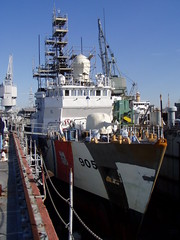 Coast Guard commandant Admiral Thad Allen has all but surrendered to critics whove been saying that the services sprawling $24-billion Deepwater modernization program is fatally flawed and rife with corruption, according to The New York Times:
Coast Guard commandant Admiral Thad Allen has all but surrendered to critics whove been saying that the services sprawling $24-billion Deepwater modernization program is fatally flawed and rife with corruption, according to The New York Times:
We have been running some parts of the Coast Guard like a small business when we are a Fortune 500 company, Admiral Allen said in a speech on Tuesday to several hundred Coast Guard officials. We need to evolve with changing times. A new deputy commandant for mission support will oversee the design, acquisition and construction of new ships and aircraft and the maintenance of the fleet once they are built, functions that are now managed separately.
That will allow the Coast Guard to avoid giving so much authority for design and construction choices to contractors, like Lockheed Martin and Northrop Grumman, which renovated the first eight trouble-plagued ships in the Deepwater program.
The boats in question are the 123-foot Island-class patrol boats first fielded more than 15 years ago. Last year, former Lockheed Martin engineer Mike DeKort called out the firm for allegedly botching improvements to the boats communications. A report from the Coast Guard Inspector General this week confirms some of the flaws, including bad wiring and leaky system security.
The eight boats were withdrawn from service a couple months ago, causing a minor panic in a service that was already short of patrol boats as it awaits the introduction of two classes of brand-new boats over the next decade.
In an email on Tuesday, DeKort declared victory:
The ICGS [partnership between Lockheed Martin and Northrop Grumman] parties involved have demonstrated themselves to be incompetent and ethically, technically and professionally bankrupt. Also the IG told me very clearly that the CG and LM were not cooperating with their investigation. They could not get data they asked for or run re-tests they asked for.
But read the IG report carefully:
Aspects of the C4ISR equipment installed aboard the 123′ cutters do not meet the design standards set forth in the Deepwater contract. Specifically, two of the four areas of concern identified by the complainant were substantiated and are the result of the contractor not complying with the design standards identified in the Deepwater contract. For example, the contractor did not install low smoke cabling aboard the 123' cutter, despite a Deepwater contract requirement that stated, all shipboard cable added as a result of the modification to the vessel shall be low smoke. The intent of this requirement was to eliminate the polyvinyl chloride jacket encasing the cables, which for years produced toxic fumes and dense smoke during shipboard fire. Additionally, the contractor installed C4ISR topside equipment aboard both the 123' cutters and prosecutors, which either did not comply or was not tested to ensure compliance with specific environmental performance requirements outlined in the Deepwater contract.
Honestly, these are relatively minor complaints. And bear in mind that the boats were withdrawn from service due to hull buckling, not due to the problems DeKort pointed out. Before the buckling became apparent, the first couple modernized boats actually performed quite well, according to one former crewman, Master Chief Eric Gallett. He dismissed DeKorts allegations as missing the point. The boats major strengths were their networked computers.
As for the hull buckling these boats were designed to last 15 years. And they did. The Coast Guard ran into problems when it tried to keep the boats past their intended service life. Keeping an aged fleet afloat while awaiting new ships is one of the services major challenges, as I describe in the current issue of Defense Technology International:
At the Coast Guard Yard in southern Maryland, the [Deepwater] revolution seems a long way off, and the rust is right in your face. At this 108-year-old facility, the Coast Guards only government-owned shipyard, 400 workers commanded by Captain Steve Duca gut, repair then piece back together the services aging medium cutters and patrol boats, keeping them afloat and livable until they can be replaced with ships like Bertholf. Ducas is delicate work like surgery, he says. And its increasingly urgent. With more than 80 cutters larger than 100 feet, the Coast Guard has the worlds 12th-largest navy. But its fleet is, on average, around a quarter-century old, making it the 38th oldest of the worlds 40 largest navies. Deepwater has suffered delays. The last new ships and aircraft wont join the force for another two decades, several years later than originally planned. So an old fleet is just getting older.
Im not one to stand by defense contractors just for the Hell of it. When theyre wrong, theyre wrong. But in this case, Lockheed Martin is guilty only of minor crimes. But these crimes have been blown out of proportion by critics. The 123s worked just fine before their ancient hulls gave out. But when these hulls did give out, folks like DeKort saw an opportunity to attack the contractors. And thats just not fair.
--David Axe, cross-posted at War Is Boring








